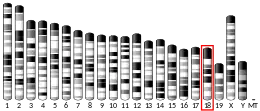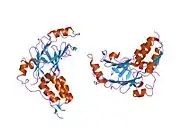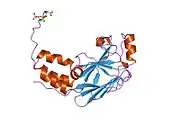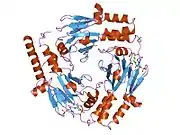SMAD2
همساخت ۲ مادران مخالف دکپنتاپلجیک (انگلیسی: Mothers against decapentaplegic homolog 2) یک پروتئین است که در انسان توسط ژن «SMAD2» کُدگذاری میشود.[4][5]
این پروتئین عضوی از خانواده بزرگ SMAD است که این نیز به نوبهٔ خود، جزئی از اَبَرخانوادهٔ فاکتور رشد تغییردهنده بتا است.
پروتئین SMAD2 در پیامرسانی سلولی و ساماندهی بیان ژن نقش دارد.
این پروتئین همچنین با مولکول SMAD3[6][7] تعامل پروتئین-پروتئین دارد.
جستارهای وابسته
منابع
- GRCm38: Ensembl release 89: ENSMUSG00000024563 - Ensembl, May 2017
- "Human PubMed Reference:". National Center for Biotechnology Information, U.S. National Library of Medicine.
- "Mouse PubMed Reference:". National Center for Biotechnology Information, U.S. National Library of Medicine.
- Eppert K, Scherer SW, Ozcelik H, Pirone R, Hoodless P, Kim H, Tsui LC, Bapat B, Gallinger S, Andrulis IL, Thomsen GH, Wrana JL, Attisano L (August 1996). "MADR2 maps to 18q21 and encodes a TGFbeta-regulated MAD-related protein that is functionally mutated in colorectal carcinoma". Cell. 86 (4): 543–52. doi:10.1016/S0092-8674(00)80128-2. PMID 8752209.
- Riggins GJ, Thiagalingam S, Rozenblum E, Weinstein CL, Kern SE, Hamilton SR, Willson JK, Markowitz SD, Kinzler KW, Vogelstein B (July 1996). "Mad-related genes in the human". Nat. Genet. 13 (3): 347–9. doi:10.1038/ng0796-347. PMID 8673135.
- Nakao A, Imamura T, Souchelnytskyi S, Kawabata M, Ishisaki A, Oeda E, Tamaki K, Hanai J, Heldin CH, Miyazono K, ten Dijke P (September 1997). "TGF-beta receptor-mediated signalling through Smad2, Smad3 and Smad4". EMBO J. 16 (17): 5353–62. doi:10.1093/emboj/16.17.5353. ISSN 0261-4189. PMC 1170167. PMID 9311995.
- Lebrun JJ, Takabe K, Chen Y, Vale W (January 1999). "Roles of pathway-specific and inhibitory Smads in activin receptor signaling". Mol. Endocrinol. 13 (1): 15–23. doi:10.1210/mend.13.1.0218. ISSN 0888-8809. PMID 9892009.
- مشارکتکنندگان ویکیپدیا. «Mothers against decapentaplegic homolog 2». در دانشنامهٔ ویکیپدیای انگلیسی، بازبینیشده در ۱۳ مارس ۲۰۲۰.
برای مطالعهٔ بیشتر
- Wrana JL (1998). "TGF-beta receptors and signalling mechanisms". Mineral and Electrolyte Metabolism. 24 (2–3): 120–30. doi:10.1159/000057359. PMID 9525694.
- Massagué J (1998). "TGF-beta signal transduction". Annu. Rev. Biochem. 67: 753–91. doi:10.1146/annurev.biochem.67.1.753. PMID 9759503.
- Verschueren K, Huylebroeck D (2000). "Remarkable versatility of Smad proteins in the nucleus of transforming growth factor-beta activated cells". Cytokine Growth Factor Rev. 10 (3–4): 187–99. doi:10.1016/S1359-6101(99)00012-X. PMID 10647776.
- Wrana JL, Attisano L (2000). "The Smad pathway". Cytokine Growth Factor Rev. 11 (1–2): 5–13. doi:10.1016/S1359-6101(99)00024-6. PMID 10708948.
- Miyazono K (2000). "TGF-beta signaling by Smad proteins". Cytokine Growth Factor Rev. 11 (1–2): 15–22. doi:10.1016/S1359-6101(99)00025-8. PMID 10708949.
- Zannis VI, Kan HY, Kritis A, Zanni E, Kardassis D (March 2001). "Transcriptional regulation of the human apolipoprotein genes". Front. Biosci. 6: D456–504. doi:10.2741/Zannis. PMID 11229886.
This article is issued from Wikipedia. The text is licensed under Creative Commons - Attribution - Sharealike. Additional terms may apply for the media files.












